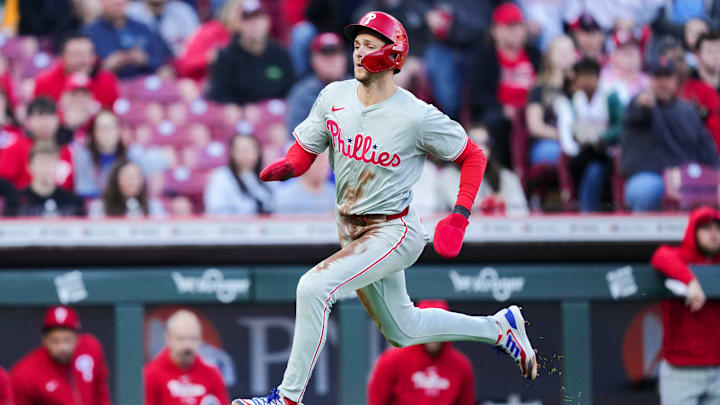The Phillies are off to a blazing start, but just not in the win column.
When breaking down speed, in terms of feet per second, the Phillies rank second in all of MLB at 27.67 ft/s, just over one-tenth of a second behind the Cincinnati Reds for the major league lead (27.78 ft/s).
the average sprint speed for each MLB teams current active roster
— BrooksGate (@Brooks_Gate) April 29, 2024
(non pitchers // feet per second) pic.twitter.com/Ey0dq8gAul
With the MLB average for sprint speed at 27 ft/s, six of the Phillies' nine regular starters are faster than the league average for running. They also have two players right around the elite mark of 30 ft/s.
Player | Sprint Speed (ft/s) |
|---|---|
Johan Rojas | 30.0 |
Trea Turner | 29.7 |
Bryson Stott | 28.9 |
J.T. Realmuto | 28.7 |
Brandon Marsh | 27.6 |
Nick Castellanos | 27.4 |
Alec Bohm | 26.0 |
Bryce Harper | 25.9 |
Kyle Schwarber | 24.8 |
Along with the regulars, players like Whit Merrifield (29.0 ft/s), Cristian Pache, and Edmundo Sosa all raise the team average. A novelty that the Phillies are blessed with that helps them achieve this mark is rostering two of the most athletic catchers in baseball.
J.T. Realmuto sits atop the list of fastest catchers with his incredible 28.7 ft/s. His backup, Garrett Stubbs, is no slouch either, ranking as the 13th fastest catcher at 26.7 ft/s. In 2023, however, he ran 28.1 ft/s, good for fifth in the league among catchers.
The only other team with two catchers inside the top 13 is the Cardinals, with their catchers ranked eighth and 12th.
How important is speed?
Speed kills. While not everyone needs speed to be effective, the ability to run provides more opportunities for more bases, more plays and more runs.
A huge part of baseball is taking the extra base. Whether it's a first-to-third situation or a ground ball into the outfield with a runner on second, it helps to have athletes who can make the turn and continue around the bases.
The Phillies are tied for the fifth-best extra base taken percentage (XBT%) in the major leagues at 47 percent. This means that 47 percent of the time, the runner advances more than one base on a single or two bases after a double. With the league average at 42 percent, it's apparent the Phillies' speed directly correlates to an increased number of runs scored per game.
They are also well above league average in most baserunning statistics that include advancing further than expected, such as runners going first to third, going second to home and run-scoring percentage.
Sprint speed of 32.1 ft/sec? He fast boiiiii#RingTheBell x @CitizensBank pic.twitter.com/yeGXtUPRv2
— Philadelphia Phillies (@Phillies) June 15, 2023
The speed is noticeable anywhere on the diamond. Players like Johan Rojas or Bryson Stott often find spots to lay down surprise bunts for hits. Like the video above, Turner is often seen legging out infield singles or turning routine plays into not so much. Even the "slower" players on the team, like Harper and Schwarber, find opportunities to go first to third and put pressure on the defense.
In a game like baseball, when things start to move faster, it can get extremely difficult. Having a team of modern-day athletes that can run the way they do opens up much more opportunity for success on the offensive side.
Speed helps on the defense, too
After the additions of Castellanos and Schwarber in the 2022 offseason, the Phillies and their fans were prepared for a completely sub-par showing on the defensive end of the outfield. After a few tweaks and changes, the Phillies have constructed one of the best defensive outfields.
A big reason why their new combination of Marsh, Rojas and Castellanos works is because they are all plus runners.
Rojas and Marsh's defensive prowess in the outfield is obvious. When watching games, most fans will see that they can simply run down most balls. When you couple that with Castellanos's tactical defensive positioning in right, if a ball is hit in the air, there is usually a Phillie under it.
Range is a great tool in the outfield, but infielders use similar motions to make plays on the dirt. Top-end speed isn't always useful in the infield, but quick turns and reactions work just the same.
Being an athletic runner pays off in many facets of our game today. Not only does it directly correlate to extra bases and runs, but the body motions, mechanics, and quickness translate to other parts of the game.
With more speed comes more opportunity. Having an experienced veteran in Turner, who has spent all his life being the fastest player on the field, gives the younger players a chance to hone that skill and put it to good use.
